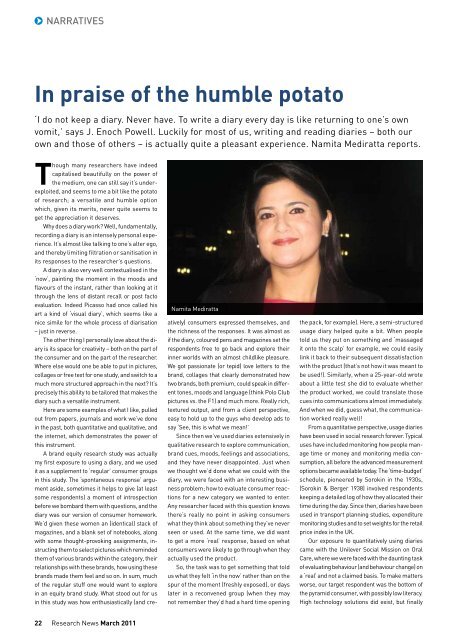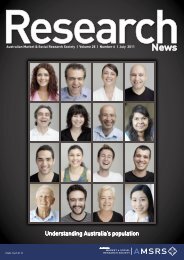Asia Pacific region - aprc-research
Asia Pacific region - aprc-research
Asia Pacific region - aprc-research
You also want an ePaper? Increase the reach of your titles
YUMPU automatically turns print PDFs into web optimized ePapers that Google loves.
NARRATIVES<br />
In praise of the humble potato<br />
‘I do not keep a diary. Never have. To write a diary every day is like returning to one’s own<br />
vomit,’ says J. Enoch Powell. Luckily for most of us, writing and reading diaries – both our<br />
own and those of others – is actually quite a pleasant experience. Namita Mediratta reports.<br />
Namita Mediratta<br />
Though many <strong>research</strong>ers have indeed<br />
capitalised beautifully on the power of<br />
the medium, one can still say it’s underexploited,<br />
and seems to me a bit like the potato<br />
of <strong>research</strong>; a versatile and humble option<br />
which, given its merits, never quite seems to<br />
get the appreciation it deserves.<br />
Why does a diary work Well, fundamentally,<br />
recording a diary is an intensely personal experience.<br />
It’s almost like talking to one’s alter ego,<br />
and thereby limiting filtration or sanitisation in<br />
its responses to the <strong>research</strong>er’s questions.<br />
A diary is also very well contextualised in the<br />
‘now’, painting the moment in the moods and<br />
flavours of the instant, rather than looking at it<br />
through the lens of distant recall or post facto<br />
evaluation. Indeed Picasso had once called his<br />
art a kind of ‘visual diary’, which seems like a<br />
nice simile for the whole process of diarisation<br />
– just in reverse.<br />
The other thing I personally love about the diary<br />
is its space for creativity – both on the part of<br />
the consumer and on the part of the <strong>research</strong>er.<br />
Where else would one be able to put in pictures,<br />
collages or free text for one study, and switch to a<br />
much more structured approach in the next It’s<br />
precisely this ability to be tailored that makes the<br />
diary such a versatile instrument.<br />
Here are some examples of what I like, pulled<br />
out from papers, journals and work we’ve done<br />
in the past, both quantitative and qualitative, and<br />
the internet, which demonstrates the power of<br />
this instrument.<br />
A brand equity <strong>research</strong> study was actually<br />
my first exposure to using a diary, and we used<br />
it as a supplement to ‘regular’ consumer groups<br />
in this study. The ‘spontaneous response’ argument<br />
aside, sometimes it helps to give (at least<br />
some respondents) a moment of introspection<br />
before we bombard them with questions, and the<br />
diary was our version of consumer homework.<br />
We’d given these women an (identical) stack of<br />
magazines, and a blank set of notebooks, along<br />
with some thought-provoking assignments, instructing<br />
them to select pictures which reminded<br />
them of various brands within the category, their<br />
relationships with these brands, how using these<br />
brands made them feel and so on. In sum, much<br />
of the regular stuff one would want to explore<br />
in an equity brand study. What stood out for us<br />
in this study was how enthusiastically (and creatively)<br />
consumers expressed themselves, and<br />
the richness of the responses. It was almost as<br />
if the diary, coloured pens and magazines set the<br />
respondents free to go back and explore their<br />
inner worlds with an almost childlike pleasure.<br />
We got passionate (or tepid) love letters to the<br />
brand, collages that clearly demonstrated how<br />
two brands, both premium, could speak in different<br />
tones, moods and language (think Polo Club<br />
pictures vs. the F1) and much more. Really rich,<br />
textured output, and from a client perspective,<br />
easy to hold up to the guys who develop ads to<br />
say ‘See, this is what we mean!’<br />
Since then we’ve used diaries extensively in<br />
qualitative <strong>research</strong> to explore communication,<br />
brand cues, moods, feelings and associations,<br />
and they have never disappointed. Just when<br />
we thought we’d done what we could with the<br />
diary, we were faced with an interesting business<br />
problem; how to evaluate consumer reactions<br />
for a new category we wanted to enter.<br />
Any <strong>research</strong>er faced with this question knows<br />
there’s really no point in asking consumers<br />
what they think about something they’ve never<br />
seen or used. At the same time, we did want<br />
to get a more ‘real’ response, based on what<br />
consumers were likely to go through when they<br />
actually used the product.<br />
So, the task was to get something that told<br />
us what they felt ‘in the now’ rather than on the<br />
spur of the moment (freshly exposed), or days<br />
later in a reconvened group (when they may<br />
not remember they’d had a hard time opening<br />
the pack, for example). Here, a semi-structured<br />
usage diary helped quite a bit. When people<br />
told us they put on something and ‘massaged<br />
it onto the scalp’ for example, we could easily<br />
link it back to their subsequent dissatisfaction<br />
with the product (that’s not how it was meant to<br />
be used!). Similarly, when a 25-year-old wrote<br />
about a little test she did to evaluate whether<br />
the product worked, we could translate those<br />
cues into communications almost immediately.<br />
And when we did, guess what, the communication<br />
worked really well!<br />
From a quantitative perspective, usage diaries<br />
have been used in social <strong>research</strong> forever. Typical<br />
uses have included monitoring how people manage<br />
time or money and monitoring media consumption,<br />
all before the advanced measurement<br />
options became available today. The ‘time-budget’<br />
schedule, pioneered by Sorokin in the 1930s,<br />
(Sorokin & Berger 1938) involved respondents<br />
keeping a detailed log of how they allocated their<br />
time during the day. Since then, diaries have been<br />
used in transport planning studies, expenditure<br />
monitoring studies and to set weights for the retail<br />
price index in the UK.<br />
Our exposure to quantitatively using diaries<br />
came with the Unilever Social Mission on Oral<br />
Care, where we were faced with the daunting task<br />
of evaluating behaviour (and behaviour change) on<br />
a ‘real’ and not a claimed basis. To make matters<br />
worse, our target respondent was the bottom of<br />
the pyramid consumer, with possibly low literacy.<br />
High technology solutions did exist, but finally<br />
22 Research News March 2011





